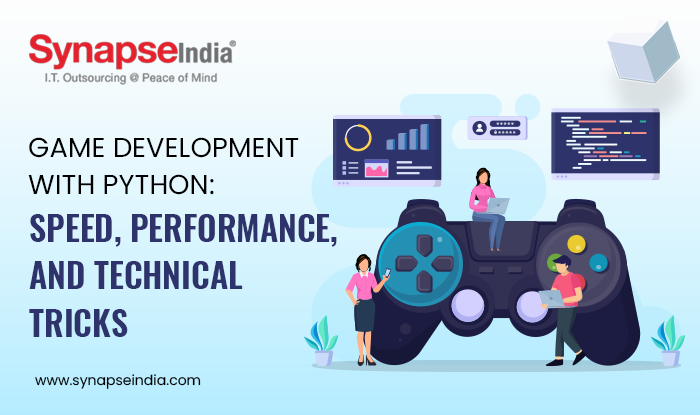 27 Nov 2023
27 Nov 2023
The game development industry has kept a great track record over the last few decades. Keeping a career in game development lets you know how to break the way in the tech industry. Python programming language is one of the best and most versatile languages for game development. In this blog, we will explore game development with Python , and what are its technical tricks in terms of speed and performance. But first, you need to understand what Python is and how it is used for different development uses.
Those days are gone when game development is only restricted to highly skilled programmers. With the emergence of Python language, game development has become an easier process. Python offers vast libraries and frameworks which is accessible to any developer skill set. Creating games with Python provides a set of tools and features in game development, as it includes physics stimulation, collision detection, and graphics rendering.

Python is a purpose-high object-oriented language and is considered one of the easiest programming languages. It includes clear and logical source code which makes it an easier option in the development process. The code in Python language is similar to the English language as it is used to structure many projects easily. Being the most versatile language in the industry it is considered for a variety of applications. Creating games with Python applications includes game development, website development, web app development, machine learning, and artificial intelligence.
Python language is considered a favorable language for game development as it offers rapid prototyping during game development. On the other hand, Python is also used to add scripts and functionalities at the backend. In terms of 3D gaming, Python is used to develop animated graphics and images to get well-executed programmers can use game development using Python called “Pygame”. It is a PySDL-based computer program used for writing video games. It includes a host of resources including modules, sound libraries, and graphics used for cross-platform game development. Pygame is installed in the computers to create games and applications.
Python has evolved as a platform for game development due to several factors that have contributed to its growth and acceptance in the gaming industry. Here are some key aspects of Python's evolution in game development:

Syntax in Python is clear and concise, it makes it easy for beginners to pick up. Due to this, there is a large active community of developers. Game development using Python simplicity allows rapid prototyping and enables developers to quickly work on experimenting with game ideas and designs.
As we all know Python has a rich ecosystem of libraries and frameworks. This caters to game development. Pygame, Panda3D, and Godot are examples of frameworks that simplify the development process. Using these frameworks the tools us used for handling common game development tasks such as graphics rendering, input handling, and physics simulation.
Python with its inherently cross-platform nature can be run on any operating system with minimal modifications. Its cross-platform compatibility makes it crucial for reaching a broader audience and simplifies the deployment of games on different platforms.
Python's community support led to the creation of extensive documentation, tutorials, and forums. With the help of this developers can easily find and help resources while working on game projects. This community-driven development also creates open-source game projects and collaborative initiatives that showcase the capabilities of Python in game development.
Python is easy to integrate with other technologies and languages. For example, Python can be used in conjunction with C/C++ for performance-critical sections of a game through libraries like Cython. Creating games with Python flexibility allows developers to leverage existing libraries and tools written in other languages, enhancing the overall capabilities of Python in game development.
Game development with Python has become increasingly popular, and while it may not be the first choice for high-performance gaming, several techniques and tricks can be employed to optimize speed and performance. Here are some tips for enhancing the speed and performance of your Python games:
Choose a game development framework like Pygame, Panda3D, or Godot. These frameworks are optimized for game development and provide built-in functionality that can help improve performance.
Profile your code to identify bottlenecks using tools like cProfile. Once you identify areas that need improvement, optimize the code in those sections. Game development using Python utilizes efficient data structures and algorithms to improve the overall performance of your game.
Consider using Cython to compile performance-critical sections of your code to C. This can significantly boost performance. PyPy is an alternative Python interpreter with a Just-In-Time (JIT) compiler, offering performance improvements over the standard CPython interpreter.
Leverage multithreading or multiprocessing to parallelize tasks and make use of multiple CPU cores. This can be especially useful for handling computationally intensive tasks concurrently.
Pygame's Surfaces can be hardware-accelerated, so use them for rendering whenever possible. Limit unnecessary copying of surfaces, as it can impact performance.
Python's evolution in game development has been attributed to its simplicity, extensive libraries and frameworks, cross-platform compatibility, community support, industry adoption, and versatility across different game genres. Game development with Python is identified to address specific bottlenecks in your code and leverage the features of the chosen framework. Additionally, Python has stayed updated on the latest developments in its ecosystem for game development. As Python continues to evolve, it is likely to maintain and expand its role in the game development landscape.

